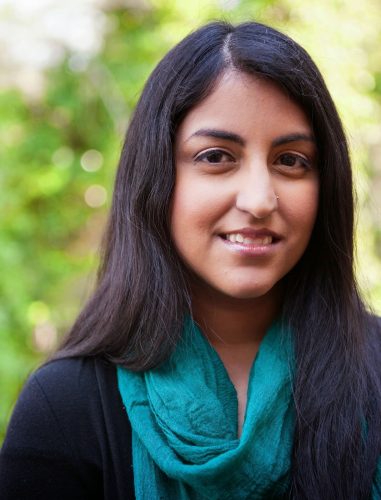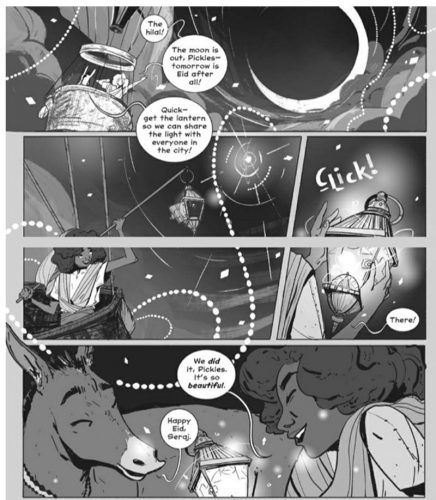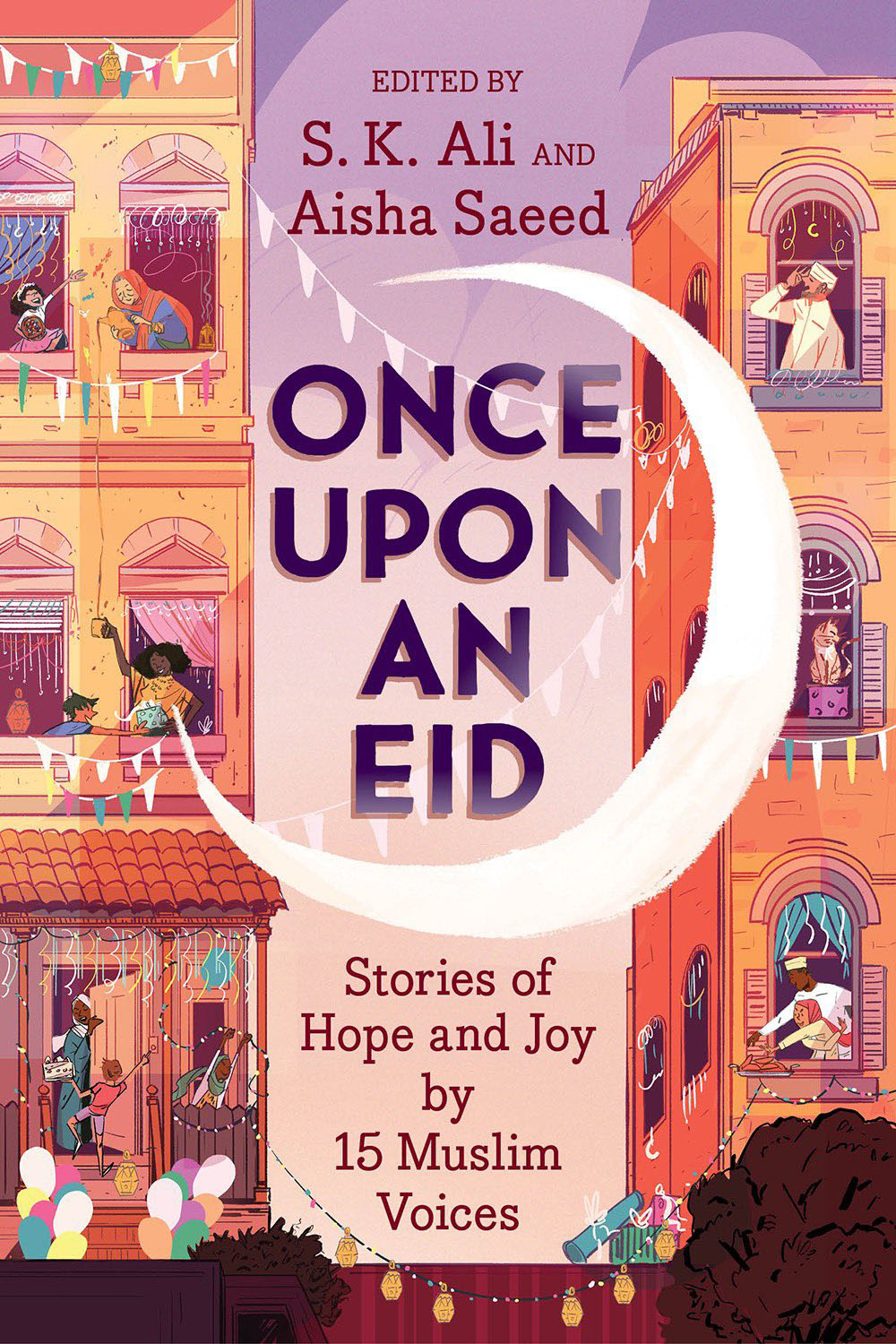Cast your eyes westward at sunset this evening (or tomorrow night) and you may just see it: the crescent moon hanging low on the horizon, signalling the end of Ramadan. In just a few hours, billions of Muslims around the world will jointly celebrate the holiday at the end of the month of fasting: Eid-ul-Fitr.
Eid is celebrated by billions of Muslims around the world, in ways that are as varied as Muslims themselves. Regardless of who is celebrating, or where they enjoy their holiday, Eid is associated with joy, hope, love and unity. month, I wanted to review a book that captured this swirl of emotions and the diversity of Eid experiences. Once Upon an Eid does this beautifully.
Once Upon an Eid is a middle-grade anthology edited by S.K. Ali and Aisha Saeed and features short stories by 15 Muslim women who jointly explore how Muslim children from various backgrounds celebrate Eid. Many of these stories are light-hearted, and show these children going through rites of passage, moments of growth or just having as much fun during Eid as they can. Others go deeper, showing how children manage to find joy in Eid even when life is unfair or imperfect.
While I wish I had enough space to talk about all of the stories in this collection, I will explore stories with themes that stood out to me. I hope you enjoy them as much as I did.
Eid is for Eating
There is so much food in Once Upon an Eid. Across the anthology, food acts as broad cultural signifiers, but also as symbols of each individual family’s holiday traditions.
Food is also comfort, and it warmed me to see how several of the featured authors used food to ease their readers into stories about children who are making the best of Eid, even when life has been unkind to them.

In “Do’nut Break Tradition” by S.K. Ali, Nadia’s mother is ill, and her family has had to significantly downsize their lives to pay for her treatments. When she wakes up on Eid, her house is so quiet, that she wonders what makes a day like Eid special, if there’s nothing special to wake up to. Throughout the story, she answers it herself when she goes to her family’s favourite bakery and orders their traditional Eid treat: a half-dozen assorted donuts. She realises that “special days start when you run toward them” and makes the best of Eid with what she has.
Hanna Alkaf’s “Taste” – a gorgeous story written in verse – has a similar theme. Lontong is a traditional Malaysian and Eid staple in Alia’s community. But her mother is indisposed and Alia must tackle the complicated dish on her own. “Lontong is Eid. And lontong is home, and lontong is Mama, even if Mama can’t be here,” she says as she plods ahead in the kitchen. “So lontong is what I’ll make and lontong is what we’ll have.” As she perseveres in the kitchen, she unravels the story of what happened to her mother as the dish overwhelms her. Just when she’s on the verge of giving up, her father comes to the rescue and they finish it in time.
Lastly, while “Searching for Blue” by N.H. Senzai doesn’t revolve around food like the previous two stories, food becomes a symbol of community, resilience, and resistance for its protagonist. Bassem is a Syrian refugee in Greece. He, his mother, and his little sister survived Assad’s air strikes, the flight from Syria to Turkey and a harrowing boat ride across the Aegean Sea to settle in Greece. One of the only things his mother was able to keep while they were on the run was her great-grandmother’s wooden cookie-mold. Throughout the story, we see Bassem’s struggles to earn money to support his family, but we also see his creativity and hopefulness and he finds a way to bring joy to his community, using his mother’s only heirloom to make the ka’ak cookies that make his Eid special.
Eid is about growth
Even when Eids are going well for the children in this collection, childhood is still messy. For so many of them, Eid becomes a rite of passage — a holiday filled with growth as well as joy.

“Perfect” by Jamilah Thompkins-Bigelow and “Not Only an Only” by Huda Al-Marashi are both stories about girls finding or reconnecting with community. In “Perfect”, Hawa and her parents are traveling to meet her father’s Guinean family in New York, which is making her anxious because of the falling out she had with her cousin Fanta on their previous visit. But, once the pair bridge their language and cultural differences, they are able to find joy in sharing for Eid.
The collection also explores how children navigate class and economic differences in their communities as well. In “Kareem means ‘Generous’” by Asmaa Hussein, the story’s namesake protagonist has been saving for weeks to buy the bike of his dreams: a Super Speedster X. When his grandmother sends him an Eid card with $40, he’s excited to reach his saving goals to buy his bike and riding gear, until he reads the note: “Did you know that your name means ‘generous’?” his grandmother writes. “Think about doing something generous with this money for Eid, will yah?” At first, Kareem resists, determined to spend the money on himself. That is until his mother forces him to go on a newspaper run with their new neighbour Shawn, who loses his bike in a hit and run accident. Kareem has to make a decision: be selfish and use all of his money for himself, or find a way to help his less fortunate new friend.
Lastly, there were stories about Muslim children’s rites of passage, my favourites being “Just Like Chest Armor” by Candice Montgomery and “Feast of Sacrifice” by Hena Khan.
In “Just like Chest Armor”, Leila is ready to wear hijab for the first time. She’s even more excited because her first scarf has come directly from her aunt. Her mother, however, encourages her to take it slow, experiment with styles at home and get comfortable wearing it in private before going to school. But Leila is having none of it, and proudly goes off to school wearing hijab for the first time. The reception is not what she is expecting. She feels the weight of her peers’ eyes on her and begins getting anxious. That is, until her seatmate surprises her with an Eid gift that warms her heart.
While “Feast of Sacrifice” is an Eid-ul-Adha story and centres Hajj and the pilgrimage to Mecca, I think it’s still worth mentioning. Humza and his two siblings are staying with their grandparents for two weeks while their parents travel to Mecca. It’s the first time they have been separated from their parents for longer than just a few hours and it’s hard on all three
siblings. It’s even harder when they realise that their grandparents celebrate Eid much more quietly, opting to spend their time cooking and sharing food at their masjid rather than focusing on more extravagant fun. At first, Humza thinks he will hate it, but as he helps his grandparents prepare and distribute their famed goat korma, he finds that helping people is much more satisfying than he thought.
Eid is Beauty

Finally, one of my favourite things about Once Upon an Eid is Sara Alfageeh’s artwork. Alfageeh does an excellent job capturing the essence and emotions of each story in the cover illustrations before each entry. Some of them are light-hearted and goofy or casually regal, or solemn and a little sad.
I love her drawings for G. Willow Wilson’s short comic “Seraj Captures the Moon” especially. The story is about a young boy who takes a hot air balloon to spot the crescent moon and capture its light to bring it back to his city. This is usually the job for the Moon Spotter, but the moon is obscured by the lights of the city and the excited lantern-wielding denizens in the streets waiting for Eid news. With his donkey, Pickles, Seraj ventures beyond the city limits to find the moon so his city can begin the Eid preparations.
Alfageeh’s work is a fantastic compliment to the prose and poetry in this collection, and made it feel even warmer and hopeful.
Conclusion
Once Upon an Eid is a book that made me smile and even laugh at loud at times. Each story captured the chaos, hope and joy of childhood holiday experiences in their own unique ways. While the children’s actions and reactions to holiday joy was universal, there was still so much to learn about the varied ways Muslims celebrate Eid around the world. I learned a lot from this collection, and I think that everyone who reads it will as well.
If there is ever a part 2 of this collection, I would love to see more representation from Caribbean authors, or even see a Guyanese iteration of this concept from local authors in the future. The book has a rich potential for expansion, and I look forward to seeing what new projects these authors and editors tackle next.
I would recommend this book to anyone who is interested in Eid stories from own voices Muslim authors, or anyone with middle-grade aged children (ages 8-12). Once Upon an Eid was wonderful and I hope you enjoy it, too.
Want to learn more about the book? Trinidadian book vlogger Saajid Hosein has an excellent video on the book.
Want to read more books by the Muslim authors featured here? Check out:
Love from A to Z by S. K. Ali
Bilal Cooks Daal by Aisha Saeed
By Any Means Necessary by Candice Montgomery
Marvel’s Ms. Marvel comic series by G. Willow Wilson
Ticket to India by N. H. Senzai






